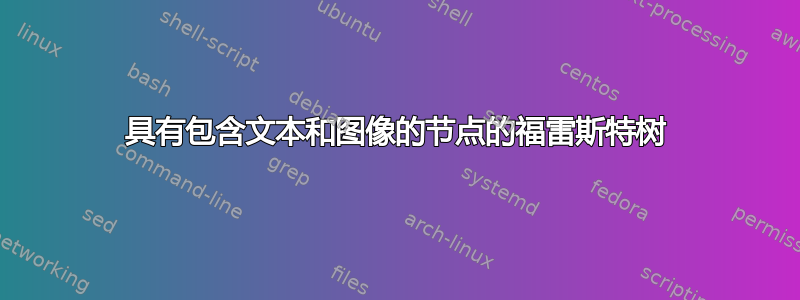
在这里找到了我需要的答案……真是一个及时、乐于助人的社区!谢谢大家。
如何创建一个带有换行文本和其下方图像的节点?
尝试1)
\begin{figure*}[ht]
\centering
\tikzset{edge from parent/.style=
{draw, edge from parent path={(\tikzparentnode.south)
-- +(0,-8pt)
-| (\tikzchildnode)}},
blank/.style={draw=none}}
\begin{tikzpicture}
\matrix
{
\node{\Tree
[.{Gaps and overlaps due to manufacturing process variation}
[.
{Tape position variation }
[.{\includegraphics[width=0.25\linewidth]{manuscript/src/figures/incorrectgeometry.jpg}} {Robot inaccuracy} {Tape lateral movement on the roller} ]
]
[.
{Tape position variation}
[.{\includegraphics[width=0.25\linewidth]{manuscript/src/figures/incorrectgeometry.jpg}} {Robot inaccuracy} {Tape lateral movement on the roller} ]
]
]};\\
};
\end{tikzpicture}
\caption{Breakdown of AFP manufacturing process variations which cause gap and overlap defects.}
\label{fig:breakdown}
\end{figure*}
尝试 2(无法弄清楚文本部分):
> \usepackage[edges]{forest} \begin{document} \forestset{ declare
> toks={graphics}{}, } \begin{forest} before typesetting nodes={
> for tree={
> content/.wrap 2 pgfmath args={\includegraphics[#2]{#1}}{content()}{graphics()},
> },
> where={isodd(n_children())}{calign=child, calign child/.wrap pgfmath arg={#1}{int((n_children()+1)/2)}}{}, }, forked edges,
> for tree={
> parent anchor=children,
> child anchor=parent,
> l sep'+=3mm,
> s sep'+=1mm,
> fork sep'+=1mm,
> edge={line width=1.5pt}, }, [incorrectgeometry.jpg, graphics={scale=0.1}
> [incorrectgeometry.jpg, graphics={scale=0.1}
> [incorrectgeometry.jpg, graphics={scale=0.1}]
> [incorrectgeometry.jpg, graphics={scale=0.1}]
> [incorrectgeometry.jpg, graphics={scale=0.1}]
> ]
> [incorrectgeometry.jpg, graphics={scale=0.1}
> [incorrectgeometry.jpg, graphics={scale=0.1}]
> ] ] \end{forest}
答案1
您可以在 es 中设置文本\parbox,并将图像作为一行添加到框后面。
\documentclass{article}
\usepackage{forest, graphicx, duckuments}
\useforestlibrary{edges}
\begin{document}
\begin{forest}
for tree={align=center, s sep=5mm, forked edge}
[Gaps and overlaps due to manufacturing process variation
[Tape position variation\\{\includegraphics[width=4cm, height=1cm]{example-image-a}}
[{\parbox[c][12mm]{32.5mm}{\centering Robot inaccuracy}}\\{\includegraphics[width=3cm]{example-image-duck}}]
[{\parbox[c][12mm]{32.5mm}{\centering Tape lateral movement on the roller}}\\{\includegraphics[width=3cm]{example-image-duck}}]
]
[Tape position variation\\{\includegraphics[width=4cm, height=1cm]{example-image-b}}
[{\parbox[c][12mm]{32.5mm}{\centering Tape width variation}}\\{\includegraphics[width=3cm]{example-image-duck}}]
[{\parbox[c][12mm]{32.5mm}{\centering Tape compaction under roller}}\\{\includegraphics[width=3cm]{example-image-duck}}]
]
]
\end{forest}
\end{document}
答案2
以下是一些代码,可帮助您开始了解我在上面的评论中提到的方向。我建议采用逐步完善的过程:
- (1)首先放置您需要的所有节点(例如绝对节点,就像我做的那样,使用矩阵,通过所述库使用相对定位等)
- (2)绘制直线互连
- 所有这些都可以帮助你把东西放在正确的位置
- (3)细化互联
广告 1,节点
- 顶层只是一个
(A)包含文本的节点 - 第二级只是为了说明,只保存另一个节点中的图形
(I1)和\coordinate(扩展名为零的 \node,即任何内容) - 第三层向你展示如何通过锚点将一个节点连接到另一个节点
广告 2,线条
您是否连接了预期的内容?您能让节点留在原处吗?
\documentclass[10pt,border=3mm,tikz]{standalone}
\usepackage{graphicx}
\begin{document}
\begin{tikzpicture}
% ~~~ (1) placing nodes first ~~~~~~~~~~
% top level
\node (A) at (0,0) {Gaps and overlaps due to manufacturing process variation};
% first level
\node (I1) at (-3,-2) {\includegraphics[width=3cm]{tape}};
\coordinate (I2) at (3,-2); % just a dummy
\node (T2) at (-5,-4) {Robot inaccuracy};
\node[anchor=north,yshift=-3mm]
at (T2.south) {\includegraphics[width=3cm]{robot}};
% ~~~ (2) draw some lines ~~~~~~~~~~
\draw (A) -- (I1);
\draw (A) -- (I2);
\draw (I1) -- (T2);
\end{tikzpicture}
\end{document}
广告 3,细化线条,即引入蜿蜒
例如这个答案使用中间点。
关于 class standalone
为什么要使用它?因为开发图纸会更容易。参见例如本示例将它们包含为 pdf在其他文件中。
图片
我从整体图中剪下了它们;无法将它们粘贴到这里,因为它们……太小了,无法上传……
答案3
我花了比预期更长的时间才创造出这种风格Sandy G 的回答。
\documentclass{standalone}
% ateb: https://tex.stackexchange.com/a/714910/ addasayd o ateb Sandy G: https://tex.stackexchange.com/a/714881/
\usepackage[edges]{forest}
\usepackage{array}
\usepackage{duckuments}
\newcolumntype{C}[1]{>{\centering}p{#1}}
\forestset{%
declare autowrapped toks={descriptor}{},
declare autowrapped toks={image}{},
declare dimen={align to}{0pt},
align me/.style={%
before typesetting nodes={
if={> Od > {align to}{0pt} } {%
align/.process={ Ow {align to}{C{##1}} },
tier/.option=level,
}{},
},
},
describe image/.style={%
delay={
align me,
split option={content}{:}{temptoksc,temptoksa},
if temptoksa={}{}{%
descriptor/.register=temptoksc,
image/.register=temptoksa,
replace by/.process={OOOw3{descriptor}{node options}{align to}{[##1,append,align to=##3,##2,forked edge,l sep'=0pt,align me]}},
delay={content/.option=image,no edge},
},
},
},
}
\begin{document}
\begin{forest}
forked edges,
for tree={
describe image,
font=\sffamily,
if level=1{% for the first level
align to'=4cm,
}{%
if level=2{% for the terminal level
align to'=3cm,
}{%
align=c,
},
},
},
[Gaps and overlaps due to manufacturing process variation
[Tape position variation:{\includegraphics[width=\linewidth, height=1cm]{example-image-a}}
[Robot\\inaccuracy:{\includegraphics[width=\linewidth]{example-image-duck}}]
[Tape lateral movement on the roller:{\includegraphics[width=\linewidth]{example-image-duck}}]
]
[Tape position variation:{\includegraphics[width=\linewidth, height=1cm]{example-image-b}}
[Tape width variation:{\includegraphics[width=\linewidth]{example-image-duck}}]
[Tape compaction under roller:{\includegraphics[width=\linewidth]{example-image-duck}}]
]
]
\end{forest}
\end{document}
[由于 Okular 错误导致没有图像:对想象力的负担表示歉意。]
来自社区,经过 2 次编译运行:








